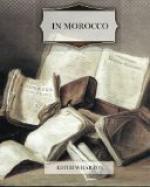A walled lane leads down from Bab F’touh to a lower slope, where the Fazi potters have their baking-kilns. Under a series of grassy terraces overgrown with olives we saw the archaic ovens and dripping wheels which produce the earthenware sold in the souks. It is a primitive and homely ware, still fine in shape, though dull in color and monotonous in pattern; and stacked on the red earth under the olives, the rows of jars and cups, in their unglazed and unpainted state, showed their classical descent more plainly than after they have been decorated.
This green quiet hollow, where turbaned figures were moving attentively among the primitive ovens, so near to the region of flies and offal we had just left, woke an old phrase in our memories, and as our mules stumbled back over the graves of Bab F’touh we understood the grim meaning of the words: “They carried him out and buried him in the Potters’ Field.”
V
MEDERSAS, BAZAARS AND AN OASIS
Fez, for two centuries and more, was in a double sense the capital of Morocco: the centre of its trade as well as of its culture.
Culture, in fact, came to northwest Africa chiefly through the Merinid princes. The Almohads had erected great monuments from Rabat to Marrakech, and had fortified Fez, but their “mighty wasteful empire” fell apart like those that had preceded it. Stability had to come from the west; it was not till the Arabs had learned it through the Moors that Morocco produced a dynasty strong and enlightened enough to carry out the dream of its founders.
Whichever way the discussion sways as to the priority of eastern or western influences on Moroccan art—whether it came to her from Syria, and was thence passed on to Spain, or was first formed in Spain, and afterward modified by the Moroccan imagination—there can at least be no doubt that Fazi art and culture, in their prime, are partly the reflection of European civilization.
Fugitives from Spain came to the new city when Moulay Idriss founded it. One part of the town was given to them, and the river divided the Elbali of the Almohads into the two quarters of Kairouiyin and Andalous, which still retain their old names. But the full intellectual and artistic flowering of Fez was delayed till the thirteenth and fourteenth centuries. It seems as though the seeds of the new springtime of art, blown across the sea from reawakening Europe, had at last given the weltering tribes of the desert the force to create their own type of beauty.
Nine Medersas sprang up in Fez, six of them built by the princes who were also creating the exquisite collegiate buildings of Sale, Rabat and old Meknez, and the enchanting mosque and minaret of Chella. The power of these rulers also was in perpetual flux, they were always at war with the Sultans of Tlemcen, the Christians of Spain, the princes of northern Algeria and Tunis. But during the fourteenth century they established a rule wide and firm enough to permit of the great outburst of art and learning which produced the Medersas of Fez.




